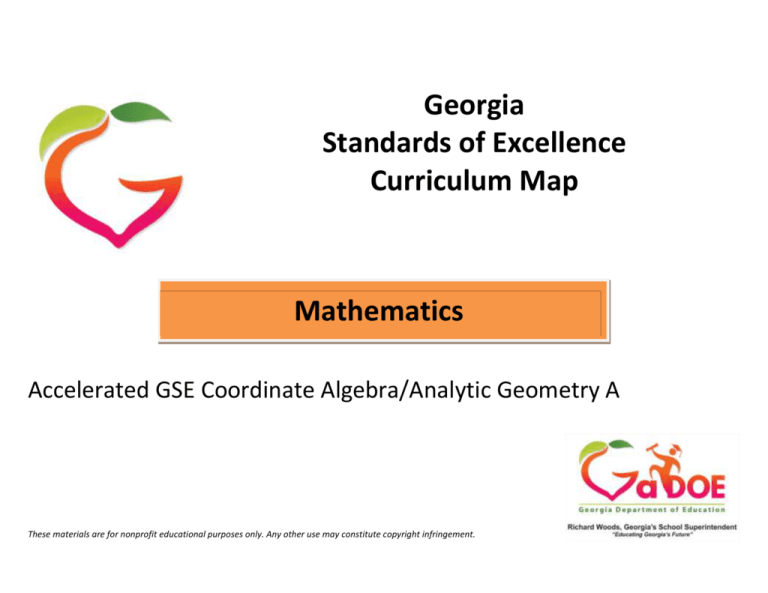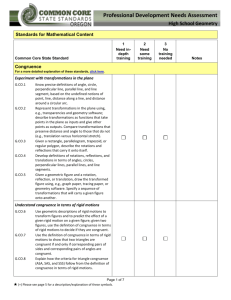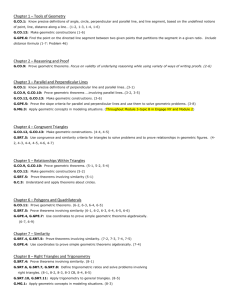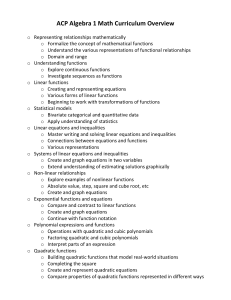
Georgia
Standards of Excellence
Curriculum Map
Mathematics
Accelerated GSE Coordinate Algebra/Analytic Geometry A
These materials are for nonprofit educational purposes only. Any other use may constitute copyright infringement.
Georgia Department of Education
Accelerated GSE Coordinate Algebra/Analytic Geometry A Curriculum Map
1st Semester
2nd Semester
Unit 1
Unit 2
Unit 3
Unit 4
Unit 5
Unit 6
Unit 7
Unit 8
Unit 9
Unit 10
(2 – 3 weeks) (2 – 3 weeks) (3 – 4 weeks) (2 – 3 weeks) (2 – 3 weeks) (2 – 3 weeks) (3 – 4 weeks) (1 – 2 weeks) (2 – 3 weeks) (1 – 2 weeks)
Relationships Reasoning
Linear and
Between
with Equations Exponential
Quantities
and
Functions
Inequalities
MGSE9-12.N.Q.1
MGSE9-12.A.REI.1
MGSE9-12.N.Q.2
MGSE9-12.A.REI.3
MGSE9-12.N.Q.3
MGSE9-12.A.REI.5
MGSE9-12.A.SSE.1 MGSE9-12.A.REI.6
MGSE9-12.A.SSE.1a MGSE9-12.A.REI.12
MGSE9-12.A.SSE.1b
MGSE9-12.A.CED.1
MGSE9-12.A.CED.2
MGSE9-12.A.CED.3
MGSE9-12.A.CED.4
MGSE9-12.A.REI.10
MGSE9-12.A.REI.11
MGSE9-12.F.IF.1
MGSE9-12.F.IF.2
MGSE9-12.F.IF.3
MGSE9-12.F.IF.4
MGSE9-12.F.IF.5
MGSE9-12.F.IF.6
MGSE9-12.F.IF.7
MGSE9-12.F.IF.7a
MGSE9-12.F.IF.e
MGSE9-12.F.IF.9
MGSE9-12.F.BF.1
MGSE9-12.F.BF.1a
MGSE9-12.F.BF.2
MGSE9-12.F.BF.3
MGSE9-12.F.LE.1
MGSE9-12.F.LE.1a
MGSE9-12.F.LE.1b
MGSE9-12.F.LE.1c
MGSE9-12.F.LE.2
MGSE9-12.F.LE.3
MGSE9-12.F.LE.5
Describing Transformations Connecting
Similarity, Right Triangle Circles and
Data
in the
Algebra and Congruence, Trigonometry
Volume
Coordinate
Geometry
and Proofs
Plane
Through
Coordinates
MGSE9-12.S.ID.1
MGSE9-12.S.ID.2
MGSE9-12.S.ID.3
MGSE9-12.S.ID.5
MGSE9-12.S.ID.6
MGSE9-12.S.ID.6a
MGSE9-12.S.ID.6c
MGSE9-12.S.ID.7
MGSE9-12.S.ID.8
MGSE9-12.S.ID.9
MGSE9-12.G.CO.1
MGSE9-12.G.CO.2
MGSE9-12.G.CO.3
MGSE9-12.G.CO.4
MGSE9-12.G.CO.5
MGSE9-12.G.GPE.4
MGSE9-12.G.GPE.5
MGSE9-12.G.GPE.6
MGSE9-12.G.GPE.7
MGSE9-12.G.SRT.1
MGSE9-12.G.SRT.2
MGSE9-12.G.SRT.3
MGSE9-12.G.SRT.4
MGSE9-12.G.SRT.5
MGSE9-12.G.CO.6
MGSE9-12.G.CO.7
MGSE9-12.G.CO.8
MGSE9-12.G.CO.9
MGSE9-12.G.CO.10
MGSE9-12.G.CO.11
MGSE9-12.G.CO.12
MGSE9-12.G.CO.13
MGSE9-12.G.GPE.4
MGSE9-12.G.SRT.6
MGSE9-12.G.SRT.7
MGSE9-12.G.SRT.8
MGSE9-12.G.C.1
MGSE9-12.G.C.2
MGSE9-12.G.C.3
MGSE9-12.G.C.4
MGSE9-12.G.C.5
MGSE9-12.G.GMD.1
MGSE9-12.G.GMD.2
MGSE9-12.G.GMD.3
MGSE9-12.G.GMD.4
Extending the
Number
System
MGSE9-12.N.RN.2
MGSE9-12.N.RN.3
MGSE9-12.A.APR.1
These units were written to build upon concepts from prior units, so later units contain tasks that depend upon the concepts addressed in earlier units.
All units will include the Mathematical Practices and indicate skills to maintain.
*Revised standards indicated in bold red font.
NOTE: Mathematical standards are interwoven and should be addressed throughout the year in as many different units and tasks as possible in order to stress the natural connections that exist among mathematical topics.
Grade 9-12 Key:
Number and Quantity Strand: RN = The Real Number System, Q = Quantities, CN = Complex Number System, VM = Vector and Matrix Quantities
Algebra Strand: SSE = Seeing Structure in Expressions, APR = Arithmetic with Polynomial and Rational Expressions, CED = Creating Equations, REI = Reasoning with Equations and Inequalities
Functions Strand: IF = Interpreting Functions, LE = Linear and Exponential Models, BF = Building Functions, TF = Trigonometric Functions
Geometry Strand: CO = Congruence, SRT = Similarity, Right Triangles, and Trigonometry, C = Circles, GPE = Expressing Geometric Properties with Equations, GMD = Geometric Measurement and Dimension,
MG Modeling with Geometry
Statistics and Probability Strand: ID = Interpreting Categorical and Quantitative Data, IC = Making Inferences and Justifying Conclusions, CP = Conditional Probability and the Rules of Probability, MD = Using Probability to
Make Decisions
Richard Woods, State School Superintendent
July 2015● Page 2 of 9
All Rights Reserved
Georgia Department of Education
Accelerated GSE Coordinate Algebra/Analytic Geometry A Expanded Curriculum Map – 1st Semester
1 Make sense of problems and persevere in solving them.
2 Reason abstractly and quantitatively.
3 Construct viable arguments and critique the reasoning of others.
4 Model with mathematics.
Standards for Mathematical Practice
5 Use appropriate tools strategically.
6 Attend to precision.
7 Look for and make use of structure.
8 Look for and express regularity in repeated reasoning.
1st Semester
Unit 1
Unit 2
Unit 3
Unit 4
Unit 5
Relationships Between
Quantities
Reasoning with Equations
and Inequalities
Linear and Exponential
Functions
Describing Data
Transformations in the
Coordinate Plane
Reason quantitatively and use units to
solve problems
MGSE9-12.N.Q.1 Use units of measure
(linear, area, capacity, rates, and time)
as a way to understand problems:
a. Identify, use, and record
appropriate units of measure
within context, within data
displays, and on graphs;
b. Convert units and rates using
dimensional analysis (English-toEnglish and Metric-to-Metric
without conversion factor
provided and between English
and Metric with conversion
factor);
c.
Use units within multi-step
problems and formulas; interpret
units of input and resulting units
of output.
MGSE9-12.N.Q.2 Define appropriate
quantities for the purpose of
descriptive modeling. Given a
situation, context, or problem, students
will determine, identify, and use
appropriate quantities for representing
the situation.
MGSE9-12.N.Q.3 Choose a level of
accuracy appropriate to limitations on
measurement when reporting
quantities. For example, money
situations are generally reported to the
nearest cent (hundredth). Also, an
answers’ precision is limited to the
precision of the data given.
Interpret the structure of expressions
MGSE9-12.A.SSE.1 Interpret
expressions that represent a quantity in
terms of its context.
MGSE9-12.A.SSE.1a Interpret parts of
an expression, such as terms, factors,
and coefficients.
Understand solving equations as a
process of reasoning and explain the
reasoning
MGSE9-12.A.REI.1 Using algebraic
properties and the properties of real
numbers, justify the steps of a simple,
one-solution equation. Students
should justify their own steps, or if
given two or more steps of an
equation, explain the progression from
one step to the next using properties.
Solve equations and inequalities in one
variable
MGSE9-12.A.REI.3 Solve linear
equations and inequalities in one
variable, including equations with
coefficients represented by letters. For
example, given ax + 3 = 7, solve for x.
Solve systems of equations
MGSE9-12.A.REI.5 Show and explain
why the elimination method works to
solve a system of two-variable
equations.
MGSE9-12.A.REI.6 Solve systems of
linear equations exactly and
approximately (e.g., with graphs),
focusing on pairs of linear equations in
two variables.
Represent and solve equations and
inequalities graphically
MGSE9-12.A.REI.12 Graph the
solution set to a linear inequality in
two variables.
Represent and solve equations and
inequalities graphically
MGSE9-12.A.REI.10 Understand that
the graph of an equation in two
variables is the set of all its solutions
plotted in the coordinate plane.
MGSE9-12.A.REI.11 Using graphs,
tables, or successive approximations,
show that the solution to the equation
f(x) = g(x) is the x-value where the yvalues of f(x) and g(x) are the same.
Understand the concept of a function
and use function notation
MGSE9-12.F.IF.1 Understand that a
function from one set (the input, called
the domain) to another set (the output,
called the range) assigns to each
element of the domain exactly one
element of the range, i.e. each input
value maps to exactly one output
value. If f is a function, x is the input
(an element of its domain), and f(x) is
the output (an element of the range).
Graphically, the graph is y = f(x).
MGSE9-12.F.IF.2 Use function
notation, evaluate functions for inputs in
their domains, and interpret statements
that use function notation in terms of a
context.
MGSE9-12.F.IF.3 Recognize that
sequences are functions, sometimes
defined recursively, whose domain is a
subset of the integers. (Generally, the
scope of high school math defines this
subset as the set of natural numbers 1,
2, 3, 4, …) By graphing or calculating
terms, students should be able to show
how the recursive sequence a1 = 7, an =
an – 1 + 2; the sequence sn = 2(n – 1) + 7;
and the function f(x) = 2x + 5 (when x
is a natural number) all define the
same sequence.
Richard Woods, State School Superintendent
July 2015● Page 3 of 9
All Rights Reserved
Summarize, represent, and interpret
data on a single count or measurement
variable
MGSE9-12.S.ID.1 Represent data with
plots on the real number line (dot plots,
histograms, and box plots).
MGSE9-12.S.ID.2 Use statistics
appropriate to the shape of the data
distribution to compare center
(median, mean) and spread
(interquartile range, mean absolute
deviation, standard deviation) of two
or more different data sets.
MGSE9-12.S.ID.3 Interpret differences
in shape, center, and spread in the
context of the data sets, accounting for
possible effects of extreme data points
(outliers).
Summarize, represent, and interpret
data on two categorical and
quantitative variables
MGSE9-12.S.ID.5 Summarize
categorical data for two categories in
two-way frequency tables. Interpret
relative frequencies in the context of the
data (including joint, marginal, and
conditional relative frequencies).
Recognize possible associations and
trends in the data.
MGSE9-12.S.ID.6 Represent data on
two quantitative variables on a scatter
plot, and describe how the variables are
related.
MGSE9-12.S.ID.6a Decide which type
of function is most appropriate by
observing graphed data, charted data,
or by analysis of context to generate a
viable (rough) function of best fit. Use
this function to solve problems in
context. Emphasize linear, quadratic,
and exponential models.
MGSE9-12.S.ID.6c Using given or
Experiment with transformations in
the plane
MGSE9-12.G.CO.1 Know precise
definitions of angle, circle, perpendicular
line, parallel line, and line segment,
based on the undefined notions of point,
line, distance along a line, and distance
around a circular arc.
MGSE9-12.G.CO.2 Represent
transformations in the plane using, e.g.,
transparencies and geometry software;
describe transformations as functions
that take points in the plane as inputs and
give other points as outputs. Compare
transformations that preserve distance
and angle to those that do not (e.g.,
translation versus horizontal stretch).
MGSE9-12.G.CO.3 Given a rectangle,
parallelogram, trapezoid, or regular
polygon, describe the rotations and
reflections that carry it onto itself.
MGSE9-12.G.CO.4 Develop definitions
of rotations, reflections, and translations
in terms of angles, circles, perpendicular
lines, parallel lines, and line segments.
MGSE9-12.G.CO.5 Given a geometric
figure and a rotation, reflection, or
translation, draw the transformed figure
using, e.g., graph paper, tracing paper, or
geometry software. Specify a sequence
of transformations that will carry a given
figure onto another.
Georgia Department of Education
MGSE9-12.A.SSE.1b Given situations
which utilize formulas or expressions
with multiple terms and/or factors,
interpret the meaning (in context) of
individual terms or factors.
Create equations that describe
numbers or relationships
MGSE9-12.A.CED.1 Create equations
and inequalities in one variable and use
them to solve problems. Include
equations arising from linear and
quadratic functions, and simple
rational and exponential functions
(integer inputs only).
MGSE9-12.A.CED.2 Create linear and
exponential equations in two or more
variables to represent relationships
between quantities; graph equations on
coordinate axes with labels and scales.
(The phrase “in two or more variables”
refers to formulas like the compound
interest formula, in which A = P(1 +
r/n)nt has multiple variables.)
MGSE9-12.A.CED.3 Represent
constraints by equations or inequalities,
and by systems of equations and/or
inequalities, and interpret data points
as possible (i.e. a solution) or not
possible (i.e. a non-solution) under the
established constraints.
MGSE9-12.A.CED.4 Rearrange
formulas to highlight a quantity of
interest, using the same reasoning as in
solving equations. Examples: Rearrange
Ohm’s law V = IR to highlight resistance
R; Rearrange area of a circle formula A
= π r2 to highlight the radius r.
Interpret functions that arise in
applications in terms of the context
MGSE9-12.F.IF.4 Using tables, graphs,
and verbal descriptions, interpret the
key characteristics of a function which
models the relationship between two
quantities. Sketch a graph showing key
features including: intercepts; intervals
where the function is increasing,
decreasing, positive, or negative;
relative maximums and minimums;
symmetries; end behavior; and
periodicity.
MGSE9-12.F.IF.5 Relate the domain of
a function to its graph and, where
applicable, to the quantitative
relationship it describes. For example, if
the function h(n) gives the number of
person-hours it takes to assemble n
engines in a factory, then the positive
integers would be an appropriate domain
for the function.
MGSE9-12.F.IF.6 Calculate and
interpret the average rate of change of a
function (presented symbolically or as a
table) over a specified interval. Estimate
the rate of change from a graph.
Analyze functions using different
representations
MGSE9-12.F.IF.7 Graph functions
expressed symbolically and show key
features of the graph, by hand in
simple cases and using technology.
MGSE9-12.F.IF.7a Graph linear and
quadratic functions and show
intercepts, maxima, and minima (as
determined by the function or by
context).
MGSE9-12.F.IF.7e Graph exponential
and logarithmic functions, showing
intercepts and end behavior, and
trigonometric functions, showing period,
midline, and amplitude.
MGSE9-12.F.IF.9 Compare properties
of two functions each represented in a
different way (algebraically,
graphically, numerically in tables, or
by verbal descriptions). For example,
given a graph of one function and an
algebraic expression for another, say
which has the larger maximum.
Build a function that models a
relationship between two quantities
MGSE9-12.F.BF.1 Write a function that
describes a relationship between two
quantities.
Richard Woods, State School Superintendent
July 2015● Page 4 of 9
All Rights Reserved
collected bivariate data, fit a linear
function for a scatter plot that suggests
a linear association.
Interpret linear models
MGSE9-12.S.ID.7 Interpret the slope
(rate of change) and the intercept
(constant term) of a linear model in the
context of the data.
MGSE9-12.S.ID.8 Compute (using
technology) and interpret the
correlation coefficient “r” of a linear
fit. (For instance, by looking at a
scatterplot, students should be able to
tell if the correlation coefficient is
positive or negative and give a
reasonable estimate of the “r” value.)
After calculating the line of best fit
using technology, students should be
able to describe how strong the
goodness of fit of the regression is,
using “r.”
MGSE9-12.S.ID.9 Distinguish between
correlation and causation.
Georgia Department of Education
MGSE9-12.F.BF.1a Determine an
explicit expression and the recursive
process (steps for calculation) from
context. For example, if Jimmy starts
out with $15 and earns $2 a day, the
explicit expression “2x+15” can be
described recursively (either in writing
or verbally) as “to find out how much
money Jimmy will have tomorrow, you
add $2 to his total today.”
J n J n1 2, J 0 15 .
MGSE9-12.F.BF.2 Write arithmetic
and geometric sequences recursively
and explicitly, use them to model
situations, and translate between the
two forms. Connect arithmetic
sequences to linear functions and
geometric sequences to exponential
functions.
Build new functions from existing
functions
MGSE9-12.F.BF.3 Identify the effect on
the graph of replacing f(x) by f(x) + k, k
f(x), f(kx), and f(x + k) for specific values
of k (both positive and negative); find the
value of k given the graphs. Experiment
with cases and illustrate an explanation
of the effects on the graph using
technology. . Include recognizing even
and odd functions from their graphs and
algebraic expressions for them.
Construct and compare linear,
quadratic, and exponential models and
solve problems
MGSE9-12.F.LE.1 Distinguish between
situations that can be modeled with
linear functions and with exponential
functions.
MGSE9-12.F.LE.1a Show that linear
functions grow by equal differences
over equal intervals and that
exponential functions grow by equal
factors over equal intervals. (This can
be shown by algebraic proof, with a
table showing differences, or by
calculating average rates of change
over equal intervals).
MGSE9-12.F.LE.1b Recognize
situations in which one quantity changes
at a constant rate per unit interval relative
to another.
MGSE9-12.F.LE.1c Recognize
situations in which a quantity grows or
decays by a constant percent rate per unit
interval relative to another.
Richard Woods, State School Superintendent
July 2015● Page 5 of 9
All Rights Reserved
Georgia Department of Education
MGSE9-12.F.LE.2 Construct linear and
exponential functions, including
arithmetic and geometric sequences,
given a graph, a description of a
relationship, or two input-output pairs
(include reading these from a table).
MGSE9-12.F.LE.3 Observe using
graphs and tables that a quantity
increasing exponentially eventually
exceeds a quantity increasing linearly,
quadratically, or (more generally) as a
polynomial function.
Interpret expressions for functions in
terms of the situation they model
MGSE9-12.F.LE.5 Interpret the
parameters in a linear (f(x) = mx + b)
and exponential (f(x) = a⦁dx) function
in terms of a context. (In the functions
above, “m” and “b” are the
parameters of the linear function, and
“a” and “d” are the parameters of the
exponential function.) In context,
students should describe what these
parameters mean in terms of change
and starting value.
Richard Woods, State School Superintendent
July 2015● Page 6 of 9
All Rights Reserved
Georgia Department of Education
Accelerated GSE Coordinate Algebra/Analytic Geometry A Expanded Curriculum Map – 2nd Semester
1 Make sense of problems and persevere in solving them.
2 Reason abstractly and quantitatively.
3 Construct viable arguments and critique the reasoning of others.
4 Model with mathematics.
Standards for Mathematical Practice
5 Use appropriate tools strategically.
6 Attend to precision.
7 Look for and make use of structure.
8 Look for and express regularity in repeated reasoning.
2nd Semester
Unit 6
Unit 7
Unit 8
Unit 9
Unit 10
Connecting Algebra and
Geometry Through
Coordinates
Similarity, Congruence, and
Proofs
Right Triangle
Trigonometry
Circles and Volume
Extending the Number
System
Use coordinates to prove simple
geometric theorems algebraically
MGSE9-12.G.GPE.4 Use coordinates
to prove simple geometric theorems
algebraically. For example, prove or
disprove that a figure defined by four
given points in the coordinate plane is a
rectangle; prove or disprove that the
point (1, √3) lies on the circle centered at
the origin and containing the point (0,2).
(Focus on quadrilaterals, right
triangles, and circles.)
MGSE9-12.G.GPE.5 Prove the slope
criteria for parallel and perpendicular
lines and use them to solve geometric
problems (e.g., find the equation of a line
parallel or perpendicular to a given line
that passes through a given point).
MGSE9-12.G.GPE.6 Find the point on a
directed line segment between two given
points that partitions the segment in a
given ratio.
MGSE9-12.G.GPE.7 Use coordinates to
compute perimeters of polygons and
areas of triangles and rectangles, e.g.,
using the distance formula.
Understand similarity in terms of
similarity transformations
MGSE9-12.G.SRT.1 Verify
experimentally the properties of
dilations given by a center and a scale
factor.
a. The dilation of a line not passing
through the center of the dilation
results in a parallel line and
leaves a line passing through the
center unchanged.
b. The dilation of a line segment is
longer or shorter according to the
ratio given by the scale factor.
MGSE9-12.G.SRT.2 Given two figures,
use the definition of similarity in terms
of similarity transformations to decide
if they are similar; explain, using
similarity transformations, the
meaning of similarity for triangles as
the equality of all corresponding pairs
of angles and the proportionality of all
corresponding pairs of sides.
MGSE9-12.G.SRT.3 Use the properties
of similarity transformations to establish
the AA criterion for two triangles to be
similar.
Prove theorems involving similarity
MGSE9-12.G.SRT.4 Prove theorems
about triangles. Theorems include: a
line parallel to one side of a triangle
divides the other two proportionally,
(and its converse); the Pythagorean
Theorem using triangle similarity.
MGSE9-12.G.SRT.5 Use congruence
and similarity criteria for triangles to
solve problems and to prove relationships
in geometric figures.
Understand congruence in terms of
rigid motions
Define trigonometric ratios and solve
problems involving right triangles
MGSE9-12.G.SRT.6 Understand that by
similarity, side ratios in right triangles
are properties of the angles in the
triangle, leading to definitions of
trigonometric ratios for acute angles.
MGSE9-12.G.SRT.7 Explain and use
the relationship between the sine and
cosine of complementary angles.
MGSE9-12.G.SRT.8 Use trigonometric
ratios and the Pythagorean Theorem to
solve right triangles in applied problems.
Understand and apply theorems about
circles
MGSE9-12.G.C.1 Understand that all
circles are similar.
MGSE9-12.G.C.2 Identify and
describe relationships among inscribed
angles, radii, chords, tangents, and
secants. Include the relationship
between central, inscribed, and
circumscribed angles; inscribed angles
on a diameter are right angles; the
radius of a circle is perpendicular to
the tangent where the radius intersects
the circle.
MGSE9-12.G.C.3 Construct the
inscribed and circumscribed circles of a
triangle, and prove properties of angles
for a quadrilateral inscribed in a circle.
MGSE9-12.G.C.4 Construct a tangent
line from a point outside a given circle to
the circle.
Find arc lengths and areas of sectors
of circles
MGSE9-12.G.C.5 Derive using
similarity the fact that the length of the
arc intercepted by an angle is
proportional to the radius, and define the
radian measure of the angle as the
constant of proportionality; derive the
formula for the area of a sector.
Explain volume formulas and use
them to solve problems
MGSE9-12.G.GMD.1 Give informal
arguments for geometric formulas.
a. Give informal arguments for the
formulas of the circumference of
a circle and area of a circle using
dissection arguments and
informal limit arguments.
b. Give informal arguments for the
Extend the properties of exponents to
rational exponents.
MGSE9-12.N.RN.2 Rewrite
expressions involving radicals and
rational exponents using the
properties of exponents. (i.e., simplify
and/or use the operations of addition,
subtraction, and multiplication, with
radicals within expressions limited to
square roots).
Use properties of rational and
irrational numbers.
MGSE9-12.N.RN.3 Explain why the
sum or product of rational numbers is
rational; why the sum of a rational
number and an irrational number is
irrational; and why the product of a
nonzero rational number and an
irrational number is irrational.
Perform arithmetic operations on
polynomials
MGSE9-12.A.APR.1 Add, subtract,
and multiply polynomials; understand
that polynomials form a system
analogous to the integers in that they
are closed under these operations.
Richard Woods, State School Superintendent
July 2015● Page 7 of 9
All Rights Reserved
Georgia Department of Education
MGSE9-12.G.CO.6 Use geometric
descriptions of rigid motions to transform
figures and to predict the effect of a given
rigid motion on a given figure; given two
figures, use the definition of congruence
in terms of rigid motions to decide if they
are congruent.
MGSE9-12.G.CO.7 Use the definition of
congruence in terms of rigid motions to
show that two triangles are congruent if
and only if corresponding pairs of sides
and corresponding pairs of angles are
congruent.
MGSE9-12.G.CO.8 Explain how the
criteria for triangle congruence (ASA,
SAS, and SSS) follow from the
definition of congruence in terms of
rigid motions. (Extend to include HL
and AAS.)
Prove geometric theorems
MGSE9-12.G.CO.9 Prove theorems
about lines and angles. Theorems include:
vertical angles are congruent; when a
transversal crosses parallel lines, alternate
interior angles are congruent and
corresponding angles are congruent;
points on a perpendicular bisector of a
line segment are exactly those equidistant
from the segment’s endpoints.
MGSE9-12.G.CO.10 Prove theorems
about triangles. Theorems include:
measures of interior angles of a triangle
sum to 180 degrees; base angles of
isosceles triangles are congruent; the
segment joining midpoints of two sides of
a triangle is parallel to the third side and
half the length; the medians of a triangle
meet at a point.
MGSE9-12.G.CO.11 Prove theorems
about parallelograms. Theorems include:
opposite sides are congruent, opposite
angles are congruent, the diagonals of a
parallelogram bisect each other, and
conversely, rectangles are parallelograms
with congruent diagonals.
Make geometric constructions
MGSE9-12.G.CO.12 Make formal
geometric constructions with a variety of
tools and methods (compass and
straightedge, string, reflective devices,
paper folding, dynamic geometric
software, etc.). Copying a segment;
copying an angle; bisecting a segment;
bisecting an angle; constructing
perpendicular lines, including the
perpendicular bisector of a line segment;
formula of the volume of a
cylinder, pyramid, and cone
using Cavalieri’s principle.
MGSE9-12.G.GMD.2 Give an informal
argument using Cavalieri’s principle for
the formulas for the volume of a sphere
and other solid figures.
MGSE9-12.G.GMD.3 Use volume
formulas for cylinders, pyramids, cones,
and spheres to solve problems.
Visualize relationships between twodimensional and three-dimensional
objects
MGSE9-12.G.GMD.4 Identify the
shapes of two-dimensional cross-sections
of three-dimensional objects, and
identify three-dimensional objects
generated by rotations of twodimensional objects.
Richard Woods, State School Superintendent
July 2015● Page 8 of 9
All Rights Reserved
Georgia Department of Education
and constructing a line parallel to a given
line through a point not on the line.
MGSE9-12.G.CO.13 Construct an
equilateral triangle, a square, and a
regular hexagon, each inscribed in a
circle.
Use coordinates to prove simple
geometric theorems algebraically
MGSE9-12.G.GPE.4 Use coordinates
to prove simple geometric theorems
algebraically. For example, prove or
disprove that a figure defined by four
given points in the coordinate plane is a
rectangle; prove or disprove that the
point (1, √3) lies on the circle centered at
the origin and containing the point (0,2).
(Focus on quadrilaterals, right
triangles, and circles.)
Richard Woods, State School Superintendent
July 2015● Page 9 of 9
All Rights Reserved






